1. How easy has it been to set up your Independent Study blog and to get used to posting things on it? Were you given enough support in doing it? What other help would have been useful?
It was easily set up and if any help was needed our teachers were there to offer their support...
2. How did the blog help with your research? Did the blog motivate you to do more and better research? How? Why?
Using a blog makes it easier to organise reserach, you can paste directly from your research source and makes it easier to refer back to...
3. Is it useful having all the Independent Study/blog tasks posted on the Macguffin blog? Does it make it more likely that you will get them done?
It helps when you miss lessons or forget to take down the homework..
4. How often (honestly!) do you check the Macguffin blog? (Remember, it should be at least twice/week).
Whenever i think that their might be homework..it depends, but usually 1-2 times a week..
5. Has it been useful being able to see and access everyone else’s research and planning through their blogs?
yea..because it helps to see what others; who are looking at similar topics have done so far and whether tehre is naything else that you need to include...
6. How do you feel about the fact that your teacher can keep a close check on your progress through accessing your blog? Is it too intrusive and controlling or is it encouraging and supportive?
Its good because the teacher can leave comments and you dont alwayz need to bring work to lessons...not so good when you havnt been keeping up to date with homework though!!
7. How useful have the comments been that you received from…a. Macguffin, b. other students.
i havnt realli recieved many overall it varies ...some are better than others...comments from macguffin are usually helpful though..
8. How has the blog helped with your essay planning? How useful was the blog when it came to writing the essay? Do you think your first draft is better because you have used a blog?
I was good for planning because you could look at how others had layed out their essay and was alwayz there to refer back to..
9. How would you evaluate the quality of your blog? What could you have done better?
i think that i could have included more by now..
10. Do you think you will get a better final grade for your independent study through having used a blog?
yea i think it helped in a lot of ways..from organisation to being given help from teachers and other students...
11. Which are the best three blogs? Why?
i havn't really seen them all but from the ones i have:
Navdeeps..alot of information on her topic and in detail.. :D
Heena..has alot of information and also pictures.. :D
There the only ones i remeber :S oopz.. i think itz because they are looking at similar topics...
12. Do you think next year’s Year 13s would benefit from setting up an Independent Study blog?
yup..
13. Are there any negative aspects to preparing for an Independent Study using a blog?
Not really...i guess technical problems with the blog can cause problems..
14. What could be done to improve teaching and/or learning in future through blogs?
ummm maybe more comments on blog entries..
15. Overall, are you pleased that we used blogs? Has it been interesting and enjoyable? Why? Why not?
yea..i like typing more than i do writing so iits more motivational and also it good being able to look at other students progress..







